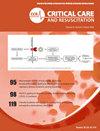Organ donation from extracorporeal membrane oxygenation and ventricular assist devices in Victoria, Australia: Characteristics and trends
IF 1.7
4区 医学
Q3 CRITICAL CARE MEDICINE
引用次数: 0
Abstract
Objective
To describe the characteristics and the trend of organ donation from donors on extracorporeal membrane oxygenation (ECMO) or ventricular assist devices (LVAD).
Design
Retrospective, observational, cohort study from June 2014 to June 2021.
Setting
A multicentre study in Victoria, Australia, using DonateLife Victoria databases.
Participants
All patients on ECMO/LVAD were referred to DonateLife for organ donation.
Main outcome measures
Number, proportion, time trend and type of organ donations from the patients on ECMO/LVAD.
Results
There were 78 donor referrals [mean (SD) age 42 (18.8) yrs, 56 (72 %) males] from patients on Veno-arterial ECMO (73 %), Veno-venous ECMO (16 %) or LVAD (6.4 %), of which 37 (47 %) donated. The annual median (IQR) referral and donation rates were 8 (5–10)/year and 4 (3–7)/year, respectively. Medical contraindications were the main reason for declining organ donation [21(51 %)]. Donation after neurological determination of death (DNDD) occurred in 20 (54 %), and donation after circulatory determination of death (DCDD) in 17 (46 %). The median (IQR) time from admission to referral for donation was longer in DCDD compared to DNDD patients. Eighty-three organs were retrieved from 37 donors (2.24 organs per donor), out of which 68 organs (82 %) were transplanted in 68 recipients. Kidneys were the most common organs retrieved (73 %) and transplanted (79 %).
Conclusion
Organ donation on ECMO/LVAD occurs only in half of the referred patients. Further studies are needed to ascertain the barriers to donations and to assess the long-term outcomes of these donations.
澳大利亚维多利亚州体外膜氧合和心室辅助装置器官捐献:特点和趋势
目的探讨体外膜氧合(ECMO)或心室辅助装置(LVAD)供体器官捐献的特点及趋势。设计2014年6月至2021年6月的回顾性、观察性、队列研究。在澳大利亚维多利亚州进行的一项多中心研究,使用维多利亚DonateLife数据库。所有采用ECMO/LVAD的患者均转介到DonateLife进行器官捐赠。主要观察指标:ECMO/LVAD患者器官捐献的数量、比例、时间趋势和类型。结果经静脉-动脉ECMO(73%)、静脉-静脉ECMO(16%)或LVAD(6.4%)患者转诊供体78例(平均年龄42岁(18.8)岁,男性56例(72%)),其中37例(47%)为供体。年中位(IQR)转诊率和捐献率分别为8(5-10)/年和4(3-7)/年。医学禁忌症是器官捐赠减少的主要原因[21(51%)]。神经系统确定死亡(DNDD)后捐赠的有20例(54%),循环系统确定死亡(DCDD)后捐赠的有17例(46%)。与ddd患者相比,DCDD患者从入院到转诊捐献的中位时间(IQR)更长。从37名供者(每名供者2.24个器官)获得83个器官,其中68个器官(82%)移植给68名受者。肾脏是最常见的器官(73%)和移植(79%)。结论ECMO/LVAD患者的器官捐献率仅为50%。需要进一步的研究来确定捐赠的障碍,并评估这些捐赠的长期结果。
本文章由计算机程序翻译,如有差异,请以英文原文为准。
求助全文
约1分钟内获得全文
求助全文
来源期刊

Critical Care and Resuscitation
CRITICAL CARE MEDICINE-
CiteScore
7.70
自引率
3.40%
发文量
44
审稿时长
>12 weeks
期刊介绍:
ritical Care and Resuscitation (CC&R) is the official scientific journal of the College of Intensive Care Medicine (CICM). The Journal is a quarterly publication (ISSN 1441-2772) with original articles of scientific and clinical interest in the specialities of Critical Care, Intensive Care, Anaesthesia, Emergency Medicine and related disciplines.
The Journal is received by all Fellows and trainees, along with an increasing number of subscribers from around the world.
The CC&R Journal currently has an impact factor of 3.3, placing it in 8th position in world critical care journals and in first position in the world outside the USA and Europe.
 求助内容:
求助内容: 应助结果提醒方式:
应助结果提醒方式:


